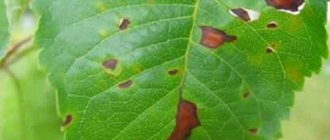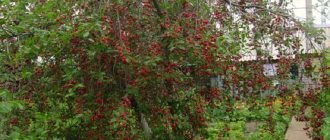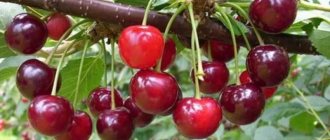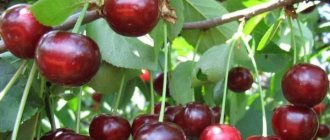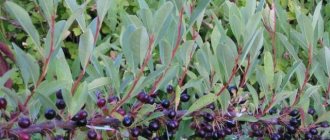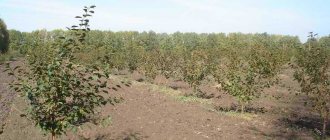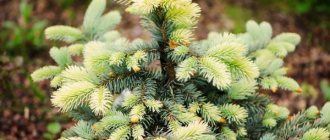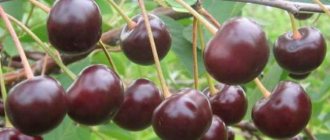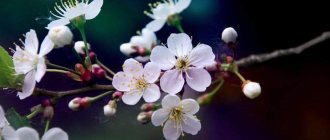Features of dwarf cherry
Dwarf cherry grows from 1 to 1.5 meters in height. Thin spreading branches give it the appearance of a bush. The leaves are small in size and shape; they grow no more than 5 cm and have a pointed end. The flowering period of dwarf cherries lasts from 2 to 3 weeks and, unlike traditional varieties, is accompanied by a rich aroma.
The berries of the dwarf tree can be from light to dark red, some varieties become almost black when ripe. The diameter of the fruit is on average 1 cm, and the average weight is no more than 5 g. A distinctive feature of low-growing trees is the early period of yield and its high yield. They can reach 10-12 kg, which is ensured by the density of the berries on the branches.
Felt cherry - varieties for the Moscow region
The homeland of the felt species is China and Korea. The main advantage is high yields with compact shrubs. There are varieties of felt cherries that are most suitable for growing in the Moscow region.
Felt cherry “Altana”
Bred in Buryatia. The fruits cannot be transported and are resistant to many diseases, in particular to fungal infections. Productivity is 3.5 – 4.5 kg per bush.
Cherry "Fairy Tale"
It can be called a Far Eastern variety, since the Far East is the birthplace of this cherry. short, only 1.3 meters in height. fast ripening, decorativeness, taste.
Cherry "White"
The variety was obtained in the Far East and is recommended for cultivation in any region, including the Moscow region. A distinctive feature of the variety is the white color of the berries, which is uncharacteristic for cherries.
Advantages and disadvantages
The main advantages of dwarf cherries are the compactness of the plant and the quality of fruiting. In terms of usefulness, they are not inferior to ordinary cherries. The advantages include the following:
- good tolerance to sudden temperature changes;
- frost resistance;
- high survival rate;
- good disease resistance;
- ease of picking berries;
- early harvest.
Growing dwarf cherries does not require much skill, so even novice gardeners can do it. Thanks to the strength of the branches, the tree is not afraid of strong winds and drafts. A well-developed root system allows the plant to survive in places with close groundwater. High yields allow the use of low-growing varieties for industrial cultivation.
The disadvantages of dwarf cherries include the small size of the berries. Some note the lack of sweetness of the fruits and their insufficient fleshiness. For planting, you need to choose the right variety and take into account the growing conditions, and the lack of pollinators for ordinary dwarf cherries is fraught with a decrease in yield.
The best varieties
Many years of work by breeders have made it possible to obtain a wide variety of varieties, so low-growing varieties are presented on the market in a wide variety. At the same time, there are representatives of dwarf trees that have won the love and recognition of Russian gardeners. For planting in the Moscow region, the best varieties are considered:
- Chocolate girl;
- Anthracite;
- Quick.
Winter pomegranate belongs to the category of new varieties; it was obtained by crossing steppe and sandy varieties of cherries. The goal of the selection was to obtain a variety that is resistant to weather changes, so the plant can easily tolerate hot weather and frost. The peculiarity of the variety is strong branches and straight growth of shoots.
See also
Description of the Ashinskaya cherry variety and fruiting characteristics, planting and careRead
The first opportunity to get a harvest can be expected in the 2-3rd year, the indicators of which increase gradually, and in the 7th year up to 8 kg of fruits are harvested. Ripening occurs in mid-August, but the fruits can remain on the branch until the end of September. The weight of the bright burgundy berry is 4 g.
Cherry Businka is a variety with a medium ripening period. The average weight of the berries is 3.5 g. The peculiarity is the color of the fruit, which is black. Winter-hardy cherries grow on average up to 3 m. The advantage of the plant is its high yield and versatility in the use of berries. The crop, when grown industrially, shows a yield of 8 t/ha. The fruiting period falls in mid-July.
Quick reference of terms
In articles devoted to cherries, there are often terms whose meaning we do not know or understand incorrectly. We will try to explain them briefly. Probably, even advanced gardeners will not refuse a kind of cheat sheet. Of course, all this information can be easily found on the Internet; here it is simply collected together.
Pollination
Most often, the terms associated with the ability of cherries to set fruit from their own pollen are not entirely correctly interpreted.
Self-fertility. Even in the absence of pollinators, cherries can produce up to 50% of the possible harvest.
Partial self-fertility. Without pollinating varieties, only 7 to 20% of berries will set.
Self-sterility. In the absence of a variety suitable for pollination, cherries will produce no more than 5% of the harvest.
Comment! For successful fruiting, the distance to the pollinator should not exceed 40 m.
Entry into fruiting
Compared to other crops (except peach), cherries begin to bear fruit early. Varieties are divided into three groups:
Precocious. The first harvest is harvested in the third or fourth year after planting.
Medium-fruited. Fruiting occurs in the fourth year.
Late-fertile. The harvest begins in the fifth or sixth year after planting.
Data are given for grafted varieties. Steppe cherry almost always begins to bear fruit earlier than ordinary cherry.
Interesting! The technical variety Lyubskaya, related to the common cherry, often blooms in the nursery.
The period of full fruiting of cherries, depending on the variety, occurs at 8-12 years of age.
Cherry sizes
According to size, cherry varieties are also divided into three groups:
Short. A tree, or more often a bush, the height of which does not exceed 2 m.
Medium height. Plant 2-4 m high.
Tall. Cherry, the height of which reaches 6-7 m or more.
Plant size is not a constant. With poor care, the cherry will be lower than the declared size, and with an excess of nitrogen fertilizers, it will be higher. In both cases, the yield and quality of the fruit will suffer.
Harvest dates
Everything seems to be clear with this. There are varieties:
Early ripening. They begin to bear fruit in late June - early July.
Mid-season. The harvest is harvested in July.
Late ripening. Cherries ripen in August.
Attention! These dates are very approximate and are given for the main territory of Russia. In Ukraine, for example, by the end of July, even most late varieties manage to finish bearing fruit.
Remember, the further south the region, the earlier the cherries ripen.
Purpose of fruits
Cherry varieties are divided into three groups:
Technical. They usually have small sour berries with a high content of vitamins and other useful elements. Eating them fresh is a dubious pleasure. But these cherries make the best jams, juices, and wines.
Universal. The berries are suitable for processing and fresh consumption.
Dining rooms. They are often called dessert. The fruits are very beautiful and tasty; they contain a lot of sugar and little acid. Such cherries are good to eat fresh, but the processed products from them are mediocre. They are distinguished by a “flat” taste and weak aroma.
Woody form of cherry
Cultivated cherries are divided into two groups based on plant shape:
Shrub. It combines steppe cherry and those varieties of common cherry that grow in the form of a multi-stemmed low bush. Typically this group is more resistant to frost than the tree group. It bears fruit mainly on last year's shoots.
Tree-like. Unites most varieties of common cherries. It forms one trunk and bears fruit mostly on bouquet branches, less often on annual shoots. Drought resistant.
Features of the fruit
Cherry fruits are divided into two unequal groups:
Morels or griots. The juice of most varieties of steppe and common cherries is rich red. It gets your hands dirty, has a pronounced aroma and noticeable sourness even in table varieties.
Amoreli. Cherry varieties with pink fruits and light juice. There are much fewer of them, they are sweeter.
A short dictionary of hybrids
Recently, many hybrids have been created. This is not least due to the desire to develop cherry varieties that are disease-resistant and can withstand severe frosts. In addition, residents of cold regions do not give up hope of getting cherries suitable for growing in the North in their gardens.
Duke. Hybrid of cherry and sweet cherry.
Cerapadus. A hybrid of cherry and Maak bird cherry, where the mother plant is cherry.
Padocerus. The result of crossing a cherry with a bird cherry, the mother plant is the Maak bird cherry.
Comment! Cherry-plum hybrids are classified as plums.
Growing principle
The tree should be planted in a well-lit place, since cherries require sufficient light. It is recommended to choose the south side of the garden; the elevation of the area is not an obstacle. Low-growing trees do not respond well to even slight shade, so despite their short stature, they should not be planted under large trees.
It is undesirable to be near coniferous trees near cherries; they are carriers of infections dangerous to them.
To avoid disappointment, the plant should be purchased from specialized nurseries. The following rules should be followed:
- choose a one- or two-year-old plant for planting, as they are acclimatized and have a sufficient degree of hardiness;
- carefully examine the roots, removing dry shoots;
- before planting, perform the soaking procedure for 10 hours in water or in a growth-stimulating solution;
- Planting should be carried out in previously prepared soil; enrichment with manure and fertilizers should be carried out in the fall.
Sandy loam soil is considered ideal for growing low-growing species, since it is characterized by sufficient looseness and easily allows air and water to pass through. The depth of the dug hole should be equal to 1⁄2 the height of the seedling. After planting, the soil needs to be moistened with 2 buckets of warm water.
Care
Caring for dwarf cherries is standard and does not require much time or effort. For successful cultivation, it is important to control watering and trim branches in a timely manner. Moisturizing is carried out as needed, increasing it during the dry season and at the time of ripening of the berries. During prolonged rains, loosening the soil is required. This will allow excess moisture to drain away in a timely manner and eliminate the risk of water stagnation.
Before flowering begins, a tree inspection is required. If there are frozen, dried shoots, you need to remove them using pruners. Pruning is carried out in early spring before the sap begins to flow. Such actions help to enhance the growth of shoots and make it possible for the tree to grow stronger during flowering. Autumn removal of branches is carried out only when absolutely necessary.
For better fruiting, it is recommended to periodically fertilize with fertilizers. The first is carried out before flowering begins after bud formation. After the flowers bloom, it is permissible to add organic matter. In the autumn, after harvesting, mineral fertilizers in the form of potassium, phosphorus and calcium are added to the soil.
See also
Description and yield characteristics of the Zhivitsa cherry variety and cultivation featuresRead
Diseases and pests
Dwarf cherry species are resistant to pests and various diseases of fruit trees. Most often they are subject to fungal infections, so it is necessary to periodically inspect them for their presence. Plantings may suffer from the following diseases:
- moniliosis;
- various types of spotting;
- scab.
Dwarf trees are often subject to aphid infestations. The greatest danger threatens seedlings when new leaves and young shoots appear. Common cherry pests include worms, moths, and fruit mites.
Fighting methods
One of the most common fungal diseases of cherries is moniliosis, which is often called monilial burn. It is easy to determine when the plant is flowering. If it is present, dry rot begins to form on the branches, they dry out, and the tree may completely die. Symptoms of damage are observed in the following sequence:
- outbreaks appear that resemble the effects of fire;
- gray growths form on the bark;
- the berries are covered with gray rot;
- branches crack and die.
To combat moniliosis, fungicides are used - “Oleocuprit”, “Kaptan”, “Kuprozan”. Before treatment, the affected areas and fruits are removed. One procedure may not be enough, in which case the manipulations are repeated.
Cherry plantings may suffer from brown or hole spotting. The disease manifests itself in the form of dark, brown or yellowish spots, in place of which holes form over time. The leaves begin to dry out and fall off. They fight this disease with a 1% solution of copper sulfate or Bordeaux mixture. The latter is also used for scab.
To prevent infection of plantings by aphids, they are sprayed with special preparations, of which there are quite a lot on the market for gardening products today. The treatment is done until the buds open. Good results are obtained when using Nitrafen or Olekuprit. At the first signs of the presence of larvae on the plant, the plantings are sprayed before the buds open. Immediately before flowering begins, the work is repeated using Karbofos.
During the gardening season, if necessary, insecticide treatment is carried out repeatedly.
Prevention
Prevention of diseases and pests is compliance with planting rules and timely removal of affected branches and fruits. The first preventive spraying is carried out after the pruning procedure, using a 1% vitriol solution for this purpose. To prevent diseases, the lower part of the shoots is whitened with lime. Spraying with a urea solution prepared from 700 g of the drug and 10 liters of water will help protect the tree from pests that have spent the winter season in the bark.
When using Bordeaux mixture, the following spraying times should be observed:
- the first - until the buds open;
- the second - after the end of flowering;
- third - no later than 3 weeks before the start of berry picking.
Spraying with Zircon or Ecoberin will help increase the tree's resistance to various pests.
Saratov baby
This variety of dwarf cherry was obtained by crossing Duke and Early cherry. Gardeners often call this variety simply Malyshka. This is a small shrub that does well in various climate zones. Characterized by high yield and winter hardiness.
The berries are bright red, beautiful, smooth. The taste of the fruit is slightly sour, pleasant. The harvest can be harvested at the end of the first month of summer. You can collect up to 15 kg of berries from one bush.
Malyshka is a self-sterile variety, so pollinators must also be planted with it. It is better to use the Lyubskaya, Nord Star or Turgenevka varieties.
The variety is resistant to diseases.
Dwarf cherries should be fed 3-4 times per season. In the spring, the trunk must be treated with whitewash. This will protect the plant from pests. Dry shoots and diseased branches are also pruned. This way the plant will receive more nutrients and pest damage will stop.
If the bush is healthy, then in the fall you can collect fallen leaves and use them later as humus. The plant is propagated by rootstock.
Preparing a plant for wintering involves performing the following procedures:
- Pruning.
- Clearing old, dried bark.
- Cleaning the crown of leaves.
- Wetting and disinfection of wounds with special solutions.
- Burning old branches and leaves.
